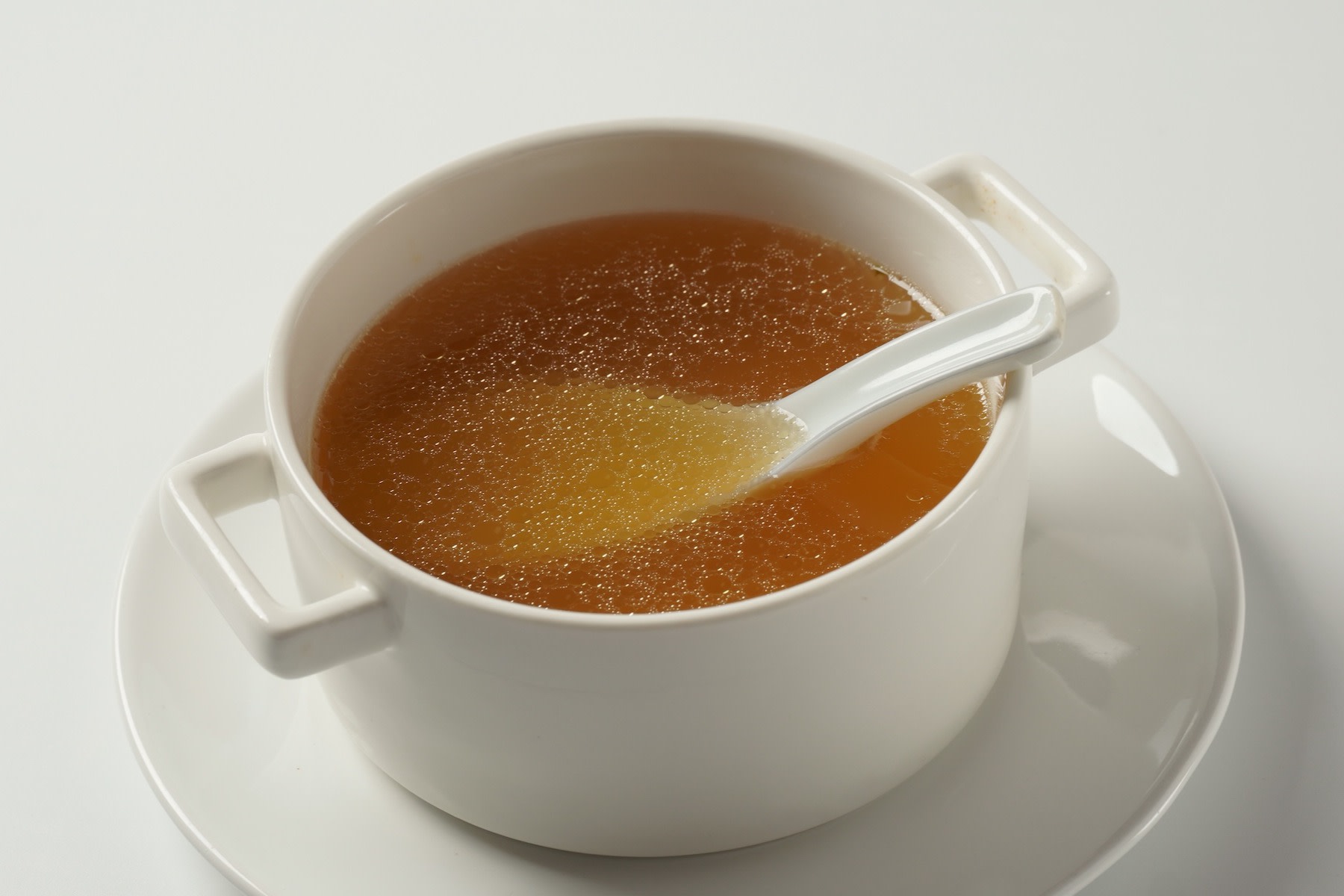
Liudmila Chernetska / iStock / Getty Images Plus via Getty Images
6 Surprisingly Impressive Benefits of Bone Broth
Bone broth is way more than a base for soup. Here’s why this nutrient-packed staple has become a favorite for fueling active lifestyles.
By Karla Walsh•
What Is Bone Broth?
6 Bone Broth Benefits
Are Certain Types of Bone Broth ‘Better’ for You?
Tips for Adding Bone Broth to Your Rotation
Much like cottage cheese went from ho-hum diner side dish to social media star, bone broth is in the middle of a renaissance. Broth was once thought of as a vehicle to put extra meat and aromatic vegetables to good use, or simply a base for soup or gravy.
Discover more ways to reach your goals with Peloton
These days, that broth is still a salve for the soul, but we’re also learning more about the legitimate bone broth benefits that make it one of the best high-protein snacks or sips.
Ahead, dietitians run us through the biggest benefits of bone broth, plus a handful of delicious ways to add this savory staple to your rotation.
What Is Bone Broth?
“Bone broth is a flavorful, nutrient-dense liquid produced from simmering bones from an animal (usually chicken, turkey, or beef) in water, alongside vegetables, herbs, and spices, for about 12–48 hours,” explains Mary Stewart, RD, a registered dietitian and the founder of Cultivate Nutrition. “Due to this longer cooking process, bone broth is rich in nutrients like collagen, hyaluronic acid, and amino acids, as well as vitamins and minerals such as calcium, potassium, phosphorus, magnesium, and zinc.”
Sometimes apple cider vinegar is added to the mix to help extract more vitamins, minerals, and collagen from the bones, adds Jena Brown, RD, a sports dietitian and the owner of Victorem Performance Nutrition. And occasionally, the bones are roasted before making bone broth to lend deeper flavor.
Bone Broth vs. Standard Broth vs. Stock
Standard broth is made with boneless meat, veggies, herbs, and spices for a fairly short time; often around 2 hours. That means it still offers a flavor and protein boost, but is lacking the bone broth benefits that come courtesy of the bones themselves.
Stock is very similar to bone broth, except the bones, veggies, and seasonings are poached in water for a shorter period of time. While bone broth cooks for 12–48 hours, stock is usually simmered for 4–8 hours, according to Brown. Since the bones have less time to stew in the liquid, they infuse it with fewer nutrients, Stewart says.
6 Bone Broth Benefits
“Bone broth has been made and consumed for centuries,” explains Kelly Jones, RD, a board-certified sports dietitian. “Recently, it has gained popularity for its protein and collagen content,” she says—but the benefits certainly don’t end there.
Read on for a shortlist of the biggest bone broth benefits you’ll score each time you sip.
1. Bone Broth Adds to Your Daily Protein Tally
The exact nutrition facts per serving will vary based on the ingredients used in your recipe, but 1 cup of bone broth contains between 7 grams and 10 grams of protein, which is on par with 2 tablespoons of peanut butter or ½ cup of black beans.
“Bone broth is packed with amino acids, the building blocks that make up proteins,” Stewart says. While all of us benefit from eating enough protein, “bone broth’s protein content can be especially beneficial for someone who is trying to build or maintain muscle mass,” she adds.
Beyond its muscle-powering abilities, protein has been found to be the most satisfying of all macronutrients. Since that’s the case, a bonus benefit of bone broth is its ability to “act as a portable protein option or to bridge longer gaps between meals,” Brown says. “Two to 3 cups is a good serving size to aim for to reach 20–30 grams of protein for a light snack.”
2. It’s a Natural Source of Collagen
About 30 percent of our body’s protein is one specific type: collagen. It plays a vital role in the construction of skin, hair, muscles, and bones, as well as the tendons and ligaments that cushion and keep our joints moving.
Collagen supplementation has been shown to help reduce joint pain, and it may help with muscle recovery, Brown says. But rather than taking actual supplements, which lack scientific support, you can sip some bone broth, which “is a natural source of collagen,” she continues. “This is a fantastic and safe alternative to taking a supplement, which may not have been third-party tested.”
3. Bone Broth Appears to Be Good for Your Gut
While more human studies are needed, some researchers believe that the collagen, gelatin, and amino acids (notably glutamine, glycine, histidine, arginine, and proline) in bone broth may benefit the digestive tract by helping to manage inflammation and reduce intestinal permeability, Jones explains. (You may have heard this referred to as “leaky gut,” although the scientific jury is still out about whether that’s the preferred term or not. It’s also not currently accepted as a legitimate medical diagnosis.)
Still, gut health affects everything from our digestion to our mood to our immune system. And while it’s important for everyone to keep in mind, this potential intestinal barrier boost may be especially impactful for individuals diagnosed with conditions like inflammatory bowel disease (IBS), Stewart notes, as they may experience “enhanced nutrient absorption.”
4. Bone Broth May Help Bolster Your Bones
Beef, chicken, and turkey bones used in bone broth are rich in minerals, including “calcium and magnesium, two hot-topic nutrients that people are thinking more about to support their own bone health and metabolism,” Jones says. “While only a small amount of these nutrients make it into bone broth, it does still contribute to daily intake of these bone-supporting micronutrients.”
In addition to helping you maintain strong bones, calcium and magnesium are important for muscle and nerve function, and magnesium in particular has also been shown to support quality sleep.
5. It’s Rich In Electrolytes
Bone broth is a natural source of electrolytes, including sodium, potassium, calcium, and magnesium, which “are essential for hydration to replace what is lost in sweat,” Brown says. Those minerals aid in ushering water back into our cells, which results in elevated cellular hydration, Stewart adds.
And not only are balanced electrolyte levels crucial for hydration, but they’re also key for muscle function, heart health, and normal nerve communication throughout the body.
6. It’s a Terrific Vehicle for Other Nutritious Foods
Only 10 percent of US adults eat enough vegetables. One of the easiest and coziest ways to sneak an extra serving or two into your diet? Veggie soup. Stewart suggests stoking a bone broth base with fresh, frozen, or roasted vegetables. The bone broth brings the protein, collagen, minerals, and electrolytes, while the veggies punch up the fiber and vitamin quotient.

Nataly Hanin / iStock / Getty Images Plus via Getty Images
Are Certain Types of Bone Broth ‘Better’ for You?
Unless you’re allergic, intolerant, or abstaining for religious or cultural reasons, all foods can have a place in a balanced diet. Still, to maximize all of the bone broth benefits mentioned above—and to promote overall health—it can be helpful to consider the different types of bone broth and what each brings to the table (literally):
If you have high blood pressure or are sensitive to salt: Reach for a low-sodium option, Stewart recommends.
If your aim is increasing muscle mass and strength: Try beef bone broth. “This contains more creatine than chicken bone broth,” Stewart says. “Creatine is a nonessential amino acid that provides energy for our muscles.”
If gut health is a priority: Chicken bone broth is the move. “This delivers specific amino acids shown to improve intestinal integrity,” Stewart says.
As you’re stocking up, check to see if the label lists the cook time. As a general rule, the best bone broths are cooked for at least 12 hours, according to Jones. If possible, seek out products without artificial additives, sugars, extracts, concentrates, and juices, Brown adds.
What if you’re vegetarian or vegan? “Unfortunately, no vegan [bone broth] alternatives match up to the protein content of bone broth,” Jones says. Your best bet for a plant-based option is miso broth, which has a bit of protein (around 3 grams per cup) and “vitamins and minerals to support gut health and immune function,” Stewart says.
Tips for Adding Bone Broth to Your Rotation
How often you eat bone broth and how much is “best” will vary depending on your goals and individual protein needs and sodium restrictions, experts say. That said, 1 cup of bone broth generally qualifies as one serving, and “high-quality bone broth can easily fit into a daily eating lifestyle,” Brown says. (Translation: 1 cup of bone broth once or twice per day is A-OK and beneficial for active individuals, Stewart confirms.)
Here are a handful of dietitian-recommended ways to incorporate bone broth into your regular menu:
Sip it straight. “When you’re craving a pick-me-up, try sipping on bone broth instead of reaching for another cup of coffee,” Stewart suggests. “Due to bone broth’s nutritional profile, it is an excellent beverage to lean on to improve your hydration, support a healthy blood sugar, and calm digestion.” Brown coaches active individuals to try incorporating a cup before or after a workout, “or even during long endurance distances to help minimize muscle breakdown and soreness. This is especially helpful when the digestion of solid foods can be difficult or less desirable,” she says.
Use it to cook grains. You know that deliciously creamy texture of risotto? That’s courtesy of slowly adding stock or broth and stirring along the way to allow the rice starches to release. Try bone broth the next time you make homemade risotto to layer on these bone broth benefits, or use it to cook rice, quinoa, or any whole grain you like. “Not only will it improve the flavor of the dish, but you are also giving it a boost of protein which can make for a more blood-sugar-friendly side dish,” Stewart says.
Or try it to infuse extra flavor into beans and legumes. For people looking to increase their intake of plant proteins, Jones recommends cooking beans and lentils in bone broth. It’ll help infuse them with a more savory flavor.
Feature it in any recipe that calls for store-bought stock. Recipes for skillet dinners, casseroles, gravies, stir-fries, pasta dishes, mashed potatoes, soups, stews, and more often call for boxed or canned stock. Bone broth works just as well and delivers a ton of benefits, so Jones recommends making that trade for an instant nutrition boost.
Related Articles
This content is for informational and educational purposes only and does not constitute individualized advice. It is not intended to replace professional medical evaluation, diagnosis, or treatment. Seek the advice of your physician for questions you may have regarding your health or a medical condition. If you are having a medical emergency, call your physician or 911 immediately.
Get our latest health stories straight to your inbox
Enter your email to get articles, expert-backed tips, and updates from Peloton sent to your inbox.
By providing your email address, you agree to receive marketing communications from Peloton.
For more about how we use your information, see our Privacy Policy.









